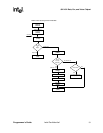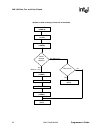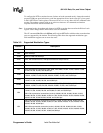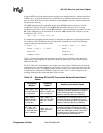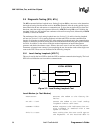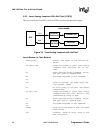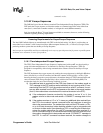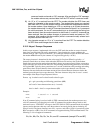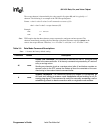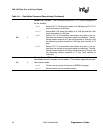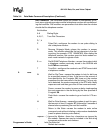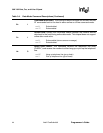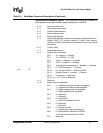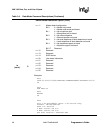
56K V.92 Data, Fax, and Voice Chipset
Programmer’s Guide Intel Confidential 39
OK command mode.
3.10 AT Escape Sequences
The 56K family provides the industry-standard Time Independent Escape Sequence (TIES). The
DTE sends the escape sequence to return the modem to command state while in the online data
state (that is, connected to another modem) or in diagnostic mode (&Tn commands).
Intel also makes the Hayes
∗
Escape Sequence available to customers; however, see the following
statement regarding licensing requirements.
3.10.1 Time-Independent Escape Sequence
The TIES (Time-Independent Escape Sequence), implemented with +++AT, was developed by a
group of modem manufacturers as an alternative to the Hayes Escape Sequence. TIES was
designed for compatibility with existing communication software written for the Hayes Escape
Sequence.
The DTE implements the escape sequence by sending the escape character (as defined in S2) three
times, followed by a valid AT command, and then the contents of S3 (typically a <CR>). Upon
detecting the three consecutive escape characters, the modem changes to TIES command mode and
starts an internal EPD (Escape Prompt Delay) timer (with the time limit defined by S12). The
modem then looks for one of the following conditions to occur:
1) No additional data is received and the EPD timer times out: the modem sends an
“OK” message to the DTE and then waits indefinitely for an incoming valid AT com-
mand string from the DTE. Until the modem receives a valid AT command, it moni-
tors any data received from the DTE and passes on the data to the remote modem
(that is, the modem does not echo back the received character to the DTE).
a) If the subsequent character received by the modem is not an ‘A’ or ‘a’, the
modem returns to data mode and sends a ‘CONNECT’ message back to the
DTE.
b) If the modem receives an “A” or “a”, it stores any additional data received from
the DTE in the modem’s internal command buffer and continues to send the
data to the remote modem. The modem then waits until the DTE sends a <CR>,
or up to 39 data characters, before deciding whether to go to command mode
or to return to data mode. Upon detecting a <CR> or receiving the 39 data char-
acters, the modem determines if a valid AT command has been received. If a
non-AT command string or an invalid command string has been received, then
the modem changes back to data mode and sends a “CONNECT” message to
the DTE. If a valid AT command has been received, the modem changes to
Licensing Requirements for Hayes Escape Sequence
The Intel 56K FastPath chipsets are manufactured with TIES as the default setting. It is Hayes’ position that you
must either have or obtain a valid license from Hayes Microcomputer Products, Inc., of Norcross, Georgia, before
producing modem systems that use the Hayes Escape Sequence.
Intel accepts no responsibility and does not indemnify nor in any way provide protection for patent or possible patent
violations to its customers or users of its products.



